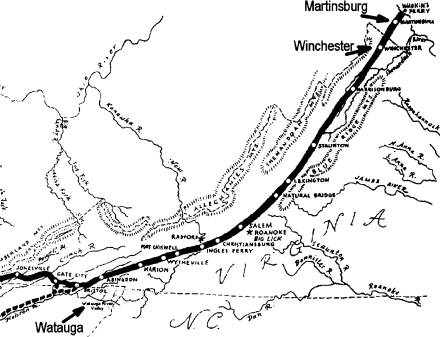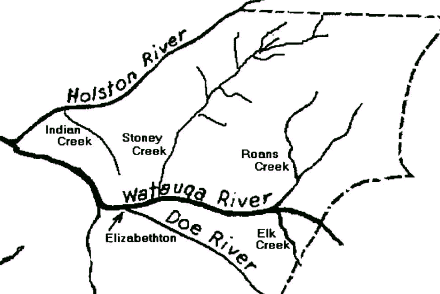|
Washington County 1789-1800 Return to Index of John May essays Continue with an essay on the family in Floyd County, Kentucky
John and Sarah's three sons were two, six and eight years old when they left Virginia. The difficulty of moving with such young children cannot be overstated. It is likely they traveled with other families from their locality, and "joined-up" with others passing through from Pennsylvania. John, Jr. was old enough to have some memories of his father preparing the wagon and his mother gathering their few possessions for housekeeping. No doubt young Samuel noticed the change in his daily routine, as his family made final preparations for the journey and bade farewell to their neighbors. The boys, however, were too young to be of much help. The most they could do was mind their parents and endure a long ride along a very bumpy road to their new home.
It was about 350 miles through Virginia along the "Great Waggon Road" to Sapling Grove (present-day Bristol, Tennessee) on the Holston River. The family left the frequently traveled route at that point and took the southern route over the last fifty miles into North Carolina. Most of the travelers leaving Sapling Grove took the Wilderness Road west into Kentucky, via the trail blazed fourteen years earlier by Daniel Boone for Colonel Henderson and the Transylvania Company. John could hope to average up to fifteen miles a day on the 400 mile journey, but bad weather and high water at the numerous fords were uncertainties he would have to face along the way. In 1790, William Blount, a signer of the U. S. Constitution for North Carolina and a speculator in western lands, was made Governor and Superintendent of Indian Affairs of the newly formed "Southwest Territory" - originally called the "Territory of the United States South of the River Ohio." The new territory had a population of about 35,000. Blount established his first official residence and headquarters in October, 1790 at Rocky Mount (near present-day Johnson City) at the mouth of the Watauga River on the Holston. President Washington's Secretary of War, Henry Knox, charged Blount with the responsibility of resolving conflicts between the Cherokees and the white settlers, a difficult task requiring exceptional tact. For a period of eighteen months, Rocky Mount was the capitol of the first recognized English-speaking government west of the Appalachian Mountains. Throughout their stay in the region, the May family lived near the mouth of Roans Creek, only a few miles up the Watauga from the site of this historic capitol. John and his neighbors must have been excited by the extension of the United States territories into their valley - promising increased protection from Indian attacks, and offering prospects of commercial development and increased land values. The date when statehood might be finally be granted was a topic of conversation for politicians and farmers alike. Land Transactions
We only have records of two land transactions that were executed by John May in Carter County, Tennessee. They document the purchase (March 14, 1798) and subsequent sale (August 8, 1800) of the same piece of property on "Elk Creek, a branch of the Watauga River, known by the name of the upper Cane break." The sale in 1800 netted John $300, giving him a stake for his future in Eastern Kentucky. Living on the Watauga
When the May family arrived in Washington County in 1789, John, Jr. was the only child over six years of age. When they left Carter County - assumed to be about August of 1800 - the ages of the four boys ranged from nine to nineteen and the two young girls' ages were about three and ten. There were limited opportunities on the Watauga for educating children. Some schools were available to families living near Elizabethton, but in the upper reaches of the valley there probably were no organized schools. Most likely none of the May children received much, if any, formal education, but we know that they were literate. A few letters known to have been written by Senator Samuel May are proof of his command of the language. REFERENCES: 1. Sewell, Juanelle S. We, The Little People, McDowell Publications, Itica, KY, 1987.
|
||||||||||||||||

